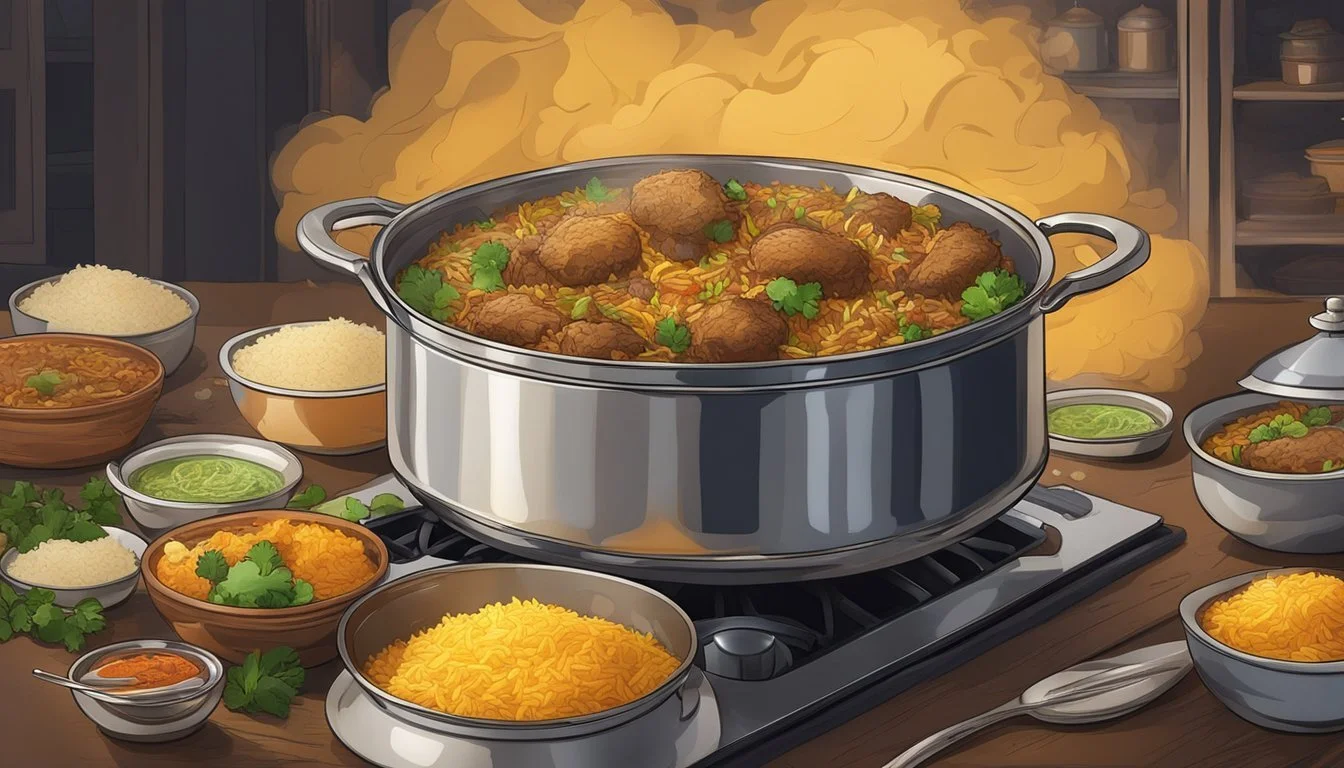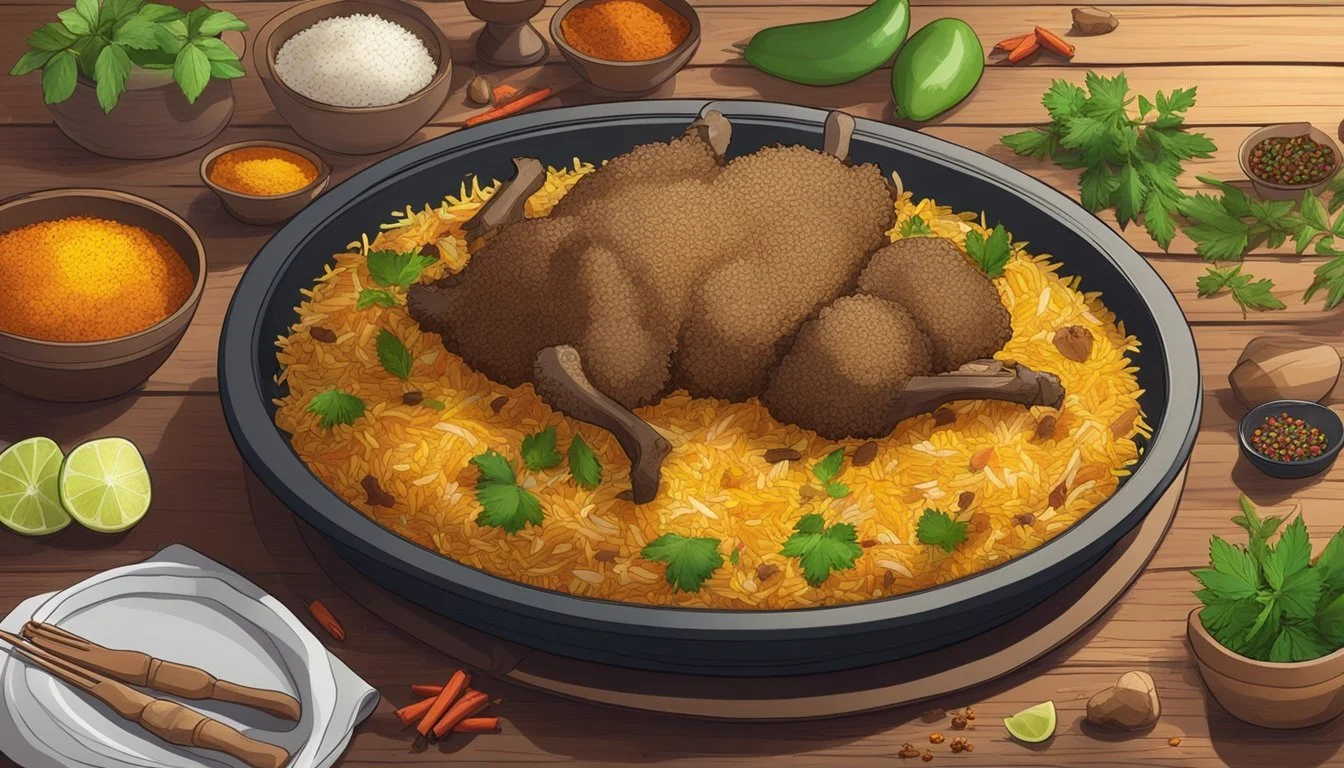Best Way to Reheat Lamb Biryani
Preserving Aroma and Taste
Reheating lamb biryani and keeping its aromatic flavors intact is a culinary challenge many face with leftovers. Lamb biryani, a dish steeped in rich spices and tender meat, is not only a delicacy fresh off the stove but also the next day, provided it's reheated properly. Given the complexity of its flavors and the delicate nature of its ingredients, special care must be taken to ensure that the reheating process does not dry out the meat or make the rice mushy.
The key to reviving leftover lamb biryani lies in a gentle reheating method that preserves moisture and sustains the vibrant blend of spices. Whether one chooses to use a skillet, oven, or microwave, attention to detail is crucial. Even distribution of heat and the addition of moisture when necessary can transform leftovers back to their original state of aromatic indulgence.
For those who treasure the nuanced flavors of lamb biryani, knowing the various reheating techniques becomes essential. Proper reheating not only maintains the integrity of the dish's taste and texture but also ensures food safety. It is necessary to heat the biryani to a safe internal temperature while respecting the delicate balance of spices that give lamb biryani its signature flavor profile.
Understanding Lamb Biryani
Lamb Biryani is a rich and complex dish, boasting a harmonious blend of tender meat, aromatic spices, and fluffy rice. This section delves into the key components and the unique taste profile of this Indian cuisine.
Ingredients Overview
Rice: The foundation of biryani is often long-grained Basmati rice, known for its delicate fragrance and fluffy texture when cooked.
Meat: Lamb is the star protein in this dish, valued for its rich, gamey flavor which pairs well with intense spices.
Spices: A mix of garam masala, cinnamon, cloves, cardamom, turmeric, and bay leaves imparts warmth and depth. Saffron threads are prized for their unique aroma and ability to impart a golden hue.
Aromatics: Onions, ginger, and garlic cloves are sautéed to create the base flavor, essential to any biryani.
Others: Tomato sauce, mint leaves, and saffron enhance the moisture content and complexity of the dish.
Flavor Profile
Lamb Biryani’s flavor is intense and nuanced, with each ingredient playing a pivotal role. The spices provide heat from cumin and a sweet note from cinnamon sticks and cardamom. The ginger and garlic add pungency, while tomato sauce brings a mild acidity and the mint leaves add a fresh element. Saffron threads not only add fragrance but also give the dish its characteristic golden color. Each bite combines these elements for a satisfying and multifaceted taste experience.
Biryani Varieties
Though Lamb Biryani is a staple, biryani comes in many forms, tailored by regional preferences and available ingredients. Some use different meats like chicken or beef, while others are vegetarian, featuring paneer or mixed vegetables. In terms of spices and garnishment, some might include paprika for a smoky flavor or cinnamon sticks for additional sweetness. Variations also occur in cooking technique, with some biryanis being more moist and saucy, while others are dry and fluffy.
Pre-Reheating Tips
Proper storage and thawing of lamb biryani are crucial to preserving its flavors and textures before reheating. Adhering to best practices ensures safety and quality.
Storage Best Practices
Lamb Biryani should be stored in an airtight container to minimize exposure to air, which can cause it to dry out or absorb unwanted odors. For refrigeration, place it in the fridge within two hours of cooking to prevent bacterial growth. It can be safely stored in the refrigerator at or below 40 degrees Fahrenheit for 3-4 days. If one needs to store it for a longer period, they should consider freezing it. For freezing, either vacuum seal the biryani or store it in heavy-duty freezer bags or airtight containers that are suitable for the freezer.
Do Don't Store in airtight containers. Leave biryani uncovered. Refrigerate within 2 hours of cooking. Allow biryani to stay at room temperature too long. Freeze if storing for more than 4 days. Freeze in containers not suitable for freezer use.
Thawing Techniques
Lamb biryani should be thawed safely to maintain quality. The best practice is to thaw the biryani in the refrigerator as it's the safest method to prevent bacterial growth; this process can take several hours or overnight, depending on the quantity. For quicker thawing, one can use the microwave's defrost setting, ensuring it doesn’t start cooking the biryani. It's not recommended to thaw lamb biryani at room temperature as it can lead to unsafe food temperatures that promote bacteria growth.
Technique Duration Notes Refrigerator Thawing Several hours to overnight Safest method, ensures even thawing. Microwave Defrosting Varies by microwave Use defrost setting; monitor to prevent cooking.
It is imperative not to rush the thawing process or compromise the biryani’s integrity. Once thawed, proceed to reheat as desired.
Reheating Lamb Biryani
Proper reheating methods are crucial for preserving the lamb biryani's moisture and aromatic flavors. Each method requires specific temperatures and techniques to ensure the dish tastes as good as when it was first prepared.
Oven Method
Temperature: Preheat the oven to 300°F (150°C).
Equipment: An oven-safe dish covered with aluminum foil ensures even heating.
Steps:
Place the lamb biryani in the dish.
Spread it evenly, gently separating any rice clumps.
Cover the dish with foil and heat for 15-20 minutes, checking occasionally.
Microwave Method
Power Level: Use medium power to avoid uneven heating.
Equipment: A microwave-safe dish is mandatory.
Steps:
Transfer the biryani to the dish. Sprinkle a few tablespoons of water to maintain moisture.
Cover with a microwave-safe lid or plastic wrap to trap steam.
Heat in 30-second intervals, stirring in between, until thoroughly warmed.
Stovetop Method
Temperature: Medium-low heat is recommended.
Equipment: A skillet with a tight-fitting lid or a steamer.
Steps for Skillet:
Add a shallow layer of water or stock to the pan, then the biryani.
Cover with a lid and allow it to steam-fry for 5-6 minutes, stirring occasionally.
Steps for Steamer:
Place the biryani in a steamer basket over simmering water.
Steam for 10-15 minutes until hot, checking the water level periodically.
Alternative Methods
Air Fryer: Preheat to 300°F and use a parchment liner. Heat the biryani for 3-4 minutes, shaking halfway through. Casserole Dish: Layer biryani in a dish and bake covered at 350°F for 35-40 minutes. Reheating Tips:
Always add a little moisture, like water or stock, before reheating.
Avoid high heat, which can dry out the biryani and cause it to lose flavor.
Maintaining Aromatic Flavors
When reheating lamb biryani, preserving the complexity of its flavors and aromas is essential. The key lies in carefully managing moisture, enhancing spices and seasonings, and adding final touches that respect the dish's integrity.
Managing Moisture
The retention of moisture is critical in reheating lamb biryani to avoid drying out the rice and meat. To ensure optimal moisture levels:
Oven Reheating: One can sprinkle a bit of water or stock before covering the dish with foil to create a steamy environment.
Stovetop Method: A splash of water or stock can be added to the bottom of the pan when reheating on low heat, allowing the biryani to steam gently.
Spices and Seasonings
Spices and seasonings are the heart of lamb biryani, with each component contributing to the overall flavor profile. Here's how to maintain their vibrancy:
Garam Masala: A pinch added during reheating can refresh the spice notes.
Saffron: Introducing a small amount of warm milk infused with saffron can revive the dish's luxurious aroma and flavor.
Garlic and Mint Sauce: Incorporating these condiments while reheating can boost the freshness and provide an additional layer of taste.
Final Touches
After reheating, a few final touches can make a significant difference:
Fresh Herbs: Toppings like chopped cilantro or mint leaves bring a burst of freshness.
Butter or Ghee: A dollop of butter or ghee melted over the hot biryani can enrich the flavors and add a silky texture.
Cucumber Raita: Serving the reheated biryani with a side of cucumber raita balances the hearty spices and adds a cooling component.
Serving Suggestions
When reheating lamb biryani, it’s essential to pair it with the right accompaniments to enhance its flavors and presentation. A carefully selected combination of sides and garnishes can elevate the dining experience.
Accompaniments
Salad: A refreshing salad can balance the rich flavors of lamb biryani. Consider a simple salad with cucumbers and a light dressing to add a crisp texture to the meal.
Mint Sauce: A drizzle of mint sauce not only complements the lamb but also adds a burst of freshness. This can be especially palate-cleansing between bites of the aromatic biryani.
Gravy or Broth: If the biryani is slightly dry after reheating, a spoonful of lamb gravy or a light broth can reintroduce moisture.
Lamb Curry: For those who enjoy a more robust flavor, a side of lamb curry can enrich the reheated biryani, giving it an extra dimension of taste.
Presentation
Layering: When serving biryani, one should layer the rice and meat to show off the variety of ingredients. This also distributes flavors evenly through each portion.
Garnishes: Sprinkle freshly chopped herbs like cilantro over the biryani for a pop of color and a hint of herbaceous aroma.
Plating: Serve biryani on a platter or in a clay pot to retain heat and add to the authenticity of the experience. If reheating chicken biryani as well, present it separately to allow guests to appreciate the distinct flavors of each dish.
Safety and Health Considerations
When reheating lamb biryani, one must prioritize safety and health to preserve not only the dish's aromatic flavors but also to prevent foodborne illness. The following key considerations should be addressed:
Temperature: Reheating should bring lamb biryani to an internal temperature of 165°F (74°C) to ensure that any potential bacteria are eradicated. Using a food thermometer can guarantee that this temperature is reached.
Ingredients: Leftover ingredients must be stored properly before reheating. The biryani should be refrigerated within two hours of cooking, and any perishable items like yogurt-based sauces should be handled with care to prevent contamination.
Leftover Lamb: Ensure the lamb is stored in airtight containers and is refrigerated as soon as possible after the initial meal. Avoid keeping the lamb biryani at room temperature for prolonged periods to minimize bacterial growth.
Reheat Lamb: When reheating, uniformly distribute heat to avoid cold spots which might harbor bacteria. Whether using an oven, stove, or microwave, stir or rotate the biryani periodically for even reheating.
| Method | Precaution
Conclusion
To ensure that lamb biryani retains its rich flavor and succulence, one must approach the reheating process with care. There are several methods available, but the chosen technique should prioritize moisture retention in the lamb and aroma preservation within the rice.
In the Oven:
For a gentle and even warming, the oven is recommended. Preheat to 300°F and loosely cover the biryani with foil to prevent drying. Heating for 20-25 minutes should suffice, depending on the portion size. Add a splash of stock to maintain the dish's moisture.
On the Stovetop:
Alternatively, use a skillet with a tight-fitting lid on medium-low heat. Begin by adding a light film of water or stock to prevent sticking and to reintroduce moisture. If desired, a pat of butter can enhance the flavor. Cover and steam for 5-6 minutes for a single serving.
Key Tips:
Heat only the portion to be served to prevent multiple reheating sessions.
Stir gently to avoid breaking the delicate grains of rice.
Avoid high heat to prevent overcooking the lamb and the spices.
By following these methods, one safeguards the integrity of the biryani. The dish remains not just a reheated meal but an experience close to its original state. Chefs and home cooks agree that the true essence of Indian recipes lies in their aromatic spices and tender meats, and careful reheating honors this tradition.





